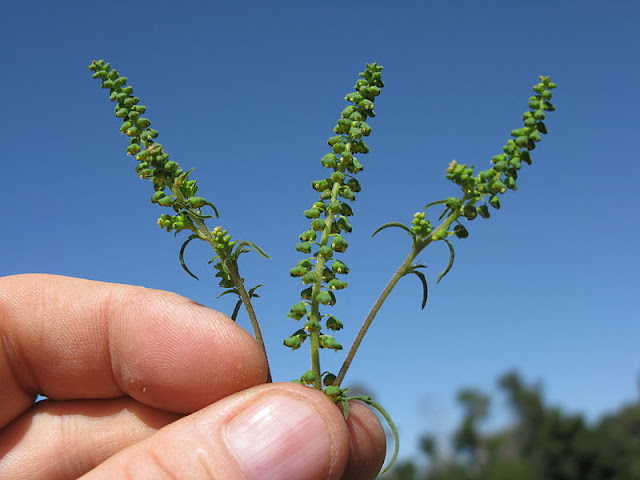About Annual Ragweed
Ragweed can be found just about anywhere this time of year from roadsides to fields, vacant lots and meadows. They are annual and perennial herbs and shrubs. Many species grow anywhere from a few inches high to about three feet high and their flowers contain both male and female flowers. The male flowers are found in the cylindrically shaped spike on the top of the flowering stalk and the female flower is found on the axils of the leaves. The plant produces two types of leaves. Large leaves divided into three to five lobes with serrated edges and long petioles are located on the lower part of the stem. Smaller, lanceolate leaves, covered with hairs on the bottom side can be seen near the base of the flowers.Common annual ragweed produces diamond shaped seeds after wind- induced pollination. A single plant may produce about a billion grains of pollen per season that is transported on the wind. Ragweed pollen is light and fluffy and can stay airborne for days and travel great distances affecting people hundreds of miles away from where the pollen originated.
Medicinal & Other Uses of Annual Ragweed
The Cherokee used annual ragweed as a ceremonial plant as an ingredient in their green corn medicine. The plant was also used as a dermatological aid; the leaves were crushed and rubbed on an insect bite, an infusion of the leaves were also used to treat hives. The Delaware made a poultice out of the plant and applied it to wounds to prevent blood poisoning. The Iroquois and the Dakota compounded a decoction of the leaves and the top part of the plant to treat diarrhea and an infusion of the roots was used as a heart medicine. The Lakota made an infusion of the leaves and used it to treat swelling. The Houma uses a decoction of this root for menstrual trouble.In addition to medicinal uses, Native Americans found several other uses for ragweed. There is evidence that Native Americans planted, cultivated, and harvested ragweed seeds. These seeds have an amazing percentage of crude protein (47%) and fat (38%) making them an important food source during the long winter months. It is said that the seed tastes like wheat. The sturdy stems of ragweed were also used by Native Americans to make rope.
Did You Know...
Cows, sheep and horses like to eat common ragweed. Excess consumption of this plant can change the taste of milk due to high content of bitter substances in the leaves of common ragweed.Eastern cottontails, voles, grasshoppers like to eat leaves of common ragweed, while dark-eyed juncos, red-bellied woodpeckers, and purple finch prefer seed.
Common ragweed effectively removes lead from the soil in the polluted areas.
The Institute for American Indian Studies
Located on 15 woodland acres the IAIS has an outdoor Three Sisters and Healing Plants Gardens as well as a replicated 16th c. Algonkian Village. Inside the museum, authentic artifacts are displayed in permanent, semi-permanent and temporary exhibits from prehistory to the present that allows visitors a walk through time. The Institute for American Indian Studies is located on 38 Curtis Road in Washington Connecticut and can be reached online or by calling 860-868-0518.





No comments:
Post a Comment